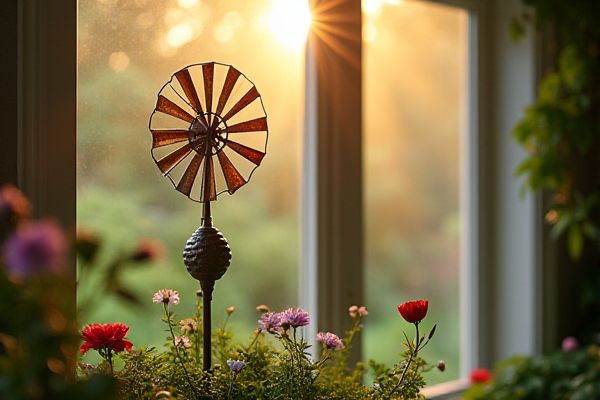
Garden wind spinners create dynamic visual interest with colorful, rotating designs that enhance your outdoor space, while weather vanes primarily serve a functional purpose of indicating wind direction with traditional or decorative shapes. Explore the rest of the article to discover which option best suits your garden's aesthetic and practical needs.
Table of Comparison
| Feature | Garden Wind Spinner | Weather Vane |
|---|---|---|
| Primary Function | Decorative motion art | Wind direction indicator |
| Design | Multi-blade, colorful, rotating elements | Arrow or figure pointing to wind |
| Material | Metal, plastic, or stainless steel | Metal (typically copper, aluminum) |
| Installation | Placed in garden soil or pots | Mounted on rooftops or high posts |
| Movement | Spins around central axis fueled by wind | Rotates freely to align with wind direction |
| Purpose | Enhances garden aesthetics | Provides wind direction data |
| Durability | Weather-resistant, varies by material | Built for outdoor permanence |
| Price Range | Low to moderate | Moderate to high |
| Common Use | Garden decoration | Weather monitoring |
Introduction to Garden Wind Spinners and Weather Vanes
Garden wind spinners and weather vanes both serve as decorative and functional outdoor elements that respond to wind movement. Garden wind spinners create dynamic visual effects with their rotating designs, adding color and motion to your landscape. Weather vanes, traditionally used to indicate wind direction, often feature classic designs that blend utility with garden charm.
Purpose and Functionality Comparison
Garden wind spinners primarily serve as decorative elements that create dynamic visual interest by rotating with the wind, enhancing garden aesthetics without providing meteorological data. Weather vanes function as practical instruments designed to indicate wind direction, offering valuable information for weather observation and prediction. While both rely on wind movement, wind spinners emphasize artistic appeal, whereas weather vanes focus on functional wind measurement.
Design and Aesthetic Differences
Garden wind spinners feature intricate, colorful designs that create dynamic visual effects as they rotate, adding vibrant movement and modern flair to any outdoor space. Weather vanes typically showcase classic, functional silhouettes such as roosters or arrows, emphasizing traditional craftsmanship and practical wind direction indication. Your choice depends on whether you prefer an eye-catching decorative element or a timeless, utilitarian garden accessory.
Materials and Construction
Garden wind spinners are often crafted from lightweight materials such as aluminum, stainless steel, or durable plastics, allowing them to spin freely even in gentle breezes. Weather vanes typically feature sturdier construction using materials like copper, wrought iron, or brass to withstand harsh weather conditions and provide longevity. Both designs emphasize corrosion resistance and balanced weight distribution to ensure functionality and durability outdoors.
Installation and Placement Requirements
Garden wind spinners require minimal installation, often needing only a simple stake or base to secure them into soil or pots, making them versatile for various garden locations. Weather vanes demand more precise mounting, typically on rooftops or elevated poles, to properly capture wind direction and avoid obstructions. Proper placement of a weather vane ensures accurate wind readings, while wind spinners are more flexible and primarily serve decorative purposes.
Maintenance and Durability
Garden wind spinners typically require less maintenance than weather vanes due to their simpler design and fewer moving parts, which reduces the risk of mechanical failure. Weather vanes, often made from metals like copper or iron, offer greater durability but can require periodic cleaning and rust prevention to maintain their functional and aesthetic quality. For your outdoor decor, choosing a wind spinner can mean less upkeep, while a weather vane provides long-lasting performance with regular care.
Wind Sensitivity and Performance
Garden wind spinners are designed with lightweight materials and multiple blades that catch even subtle breezes, providing continuous visual movement and enhanced wind sensitivity. Weather vanes, typically constructed from heavier metals with a single directional arrow or figure, perform best in moderate to strong winds to accurately indicate wind direction. While wind spinners excel in aesthetic motion during light winds, weather vanes offer precise directional information but require sufficient wind force to operate effectively.
Cost and Value Considerations
Garden wind spinners generally offer a more affordable option, with prices ranging from $20 to $100 depending on size and material, making them accessible for decorative purposes. Weather vanes, often crafted from durable metals like copper or iron, typically cost between $100 and $400, reflecting their functional value in indicating wind direction along with aesthetic appeal. Choosing between the two depends on budget priorities and whether functionality or purely ornamental value is desired.
Decorative and Practical Uses
Garden wind spinners offer vibrant, eye-catching movement that enhances your outdoor decor with artistic flair, while weather vanes provide functional value by clearly indicating wind direction for practical weather observation. Both garden wind spinners and weather vanes can serve as focal points in landscaping, but weather vanes deliver precise meteorological data, making them favored by those monitoring local weather patterns. Choosing between a garden wind spinner and a weather vane depends on whether your priority is dynamic visual appeal or accurate weather functionality.
Choosing the Right Option for Your Garden
Garden wind spinners offer vibrant, decorative movement that enhances visual appeal, while weather vanes provide practical wind direction readings for weather monitoring. Selecting between a garden wind spinner and a weather vane depends on whether your priority is aesthetic enhancement or functional utility in outdoor spaces. Consider material durability, installation ease, and design style to ensure the chosen option complements your garden's environment and purpose.
 homyna.com
homyna.com